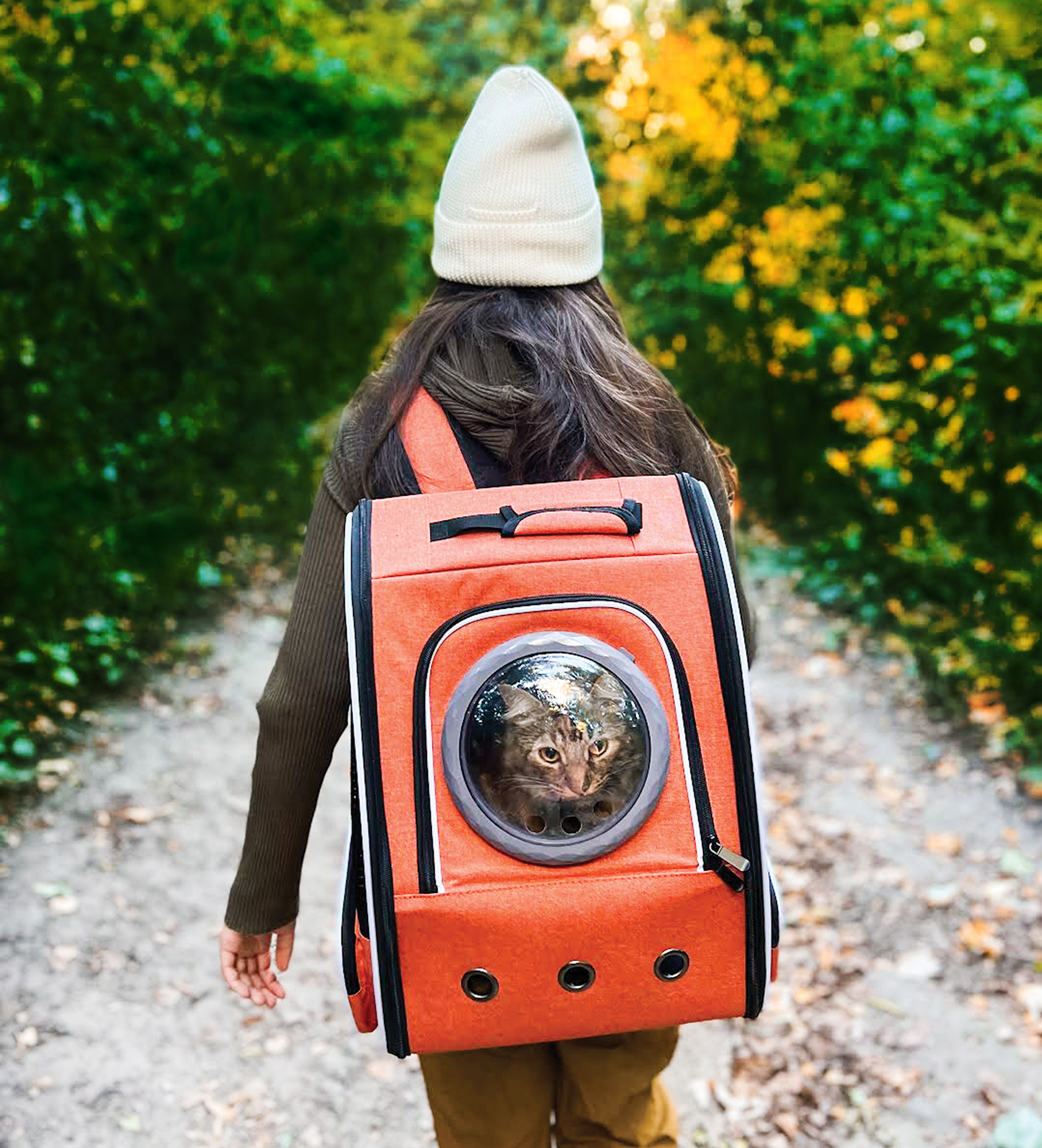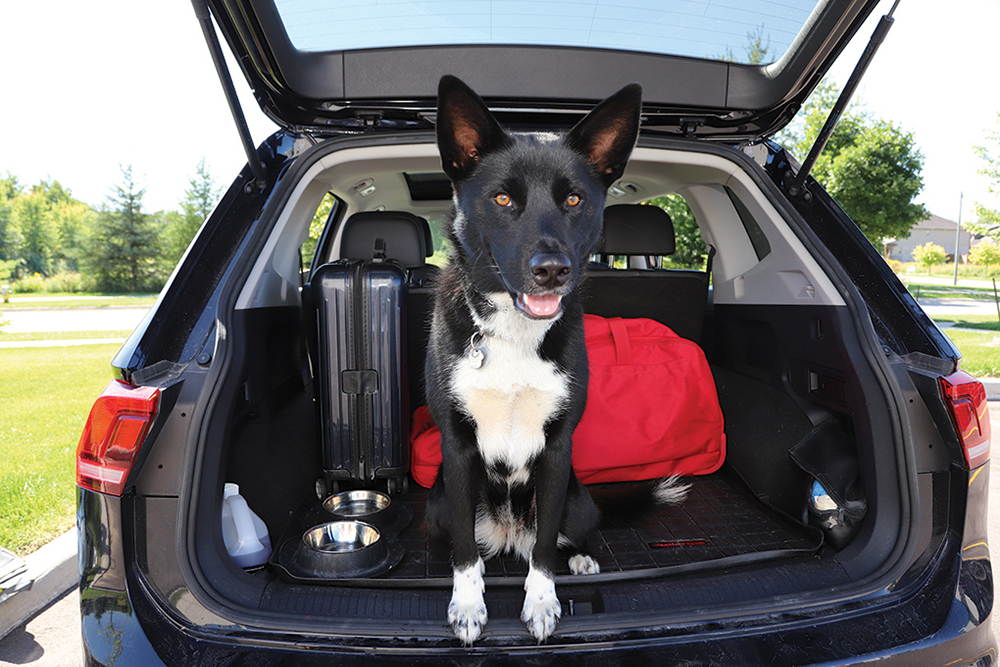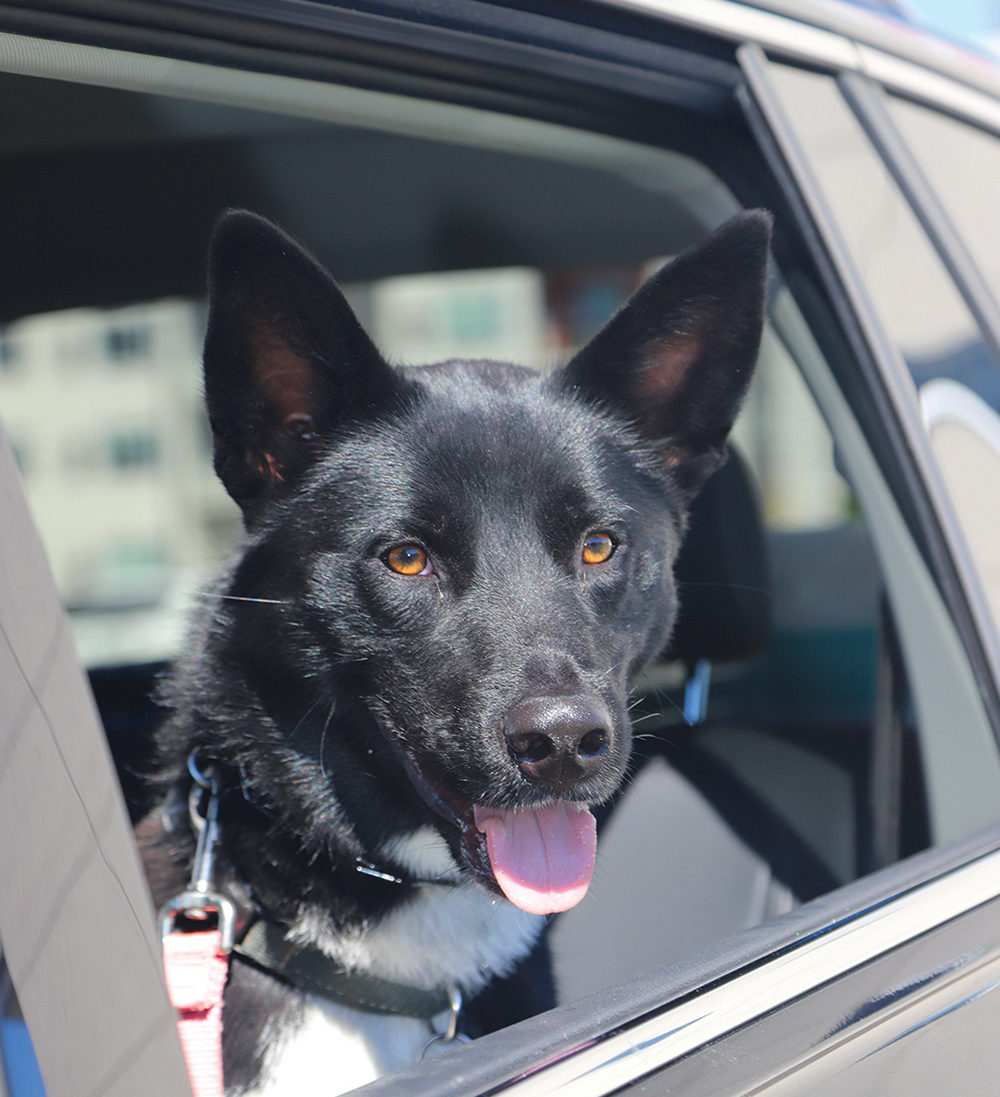How not to get peed on, and other important
road trip tips for travelling with your pet.
by Dianne Rinehart // photo by Anya Shor
Yup, my two friends, whom I’m travelling in tandem with, have just realized they left their pup, Cory, back at the gas station. Both thought the other had put the sweet, shepherd-mix dog into the van.
We both do U-turns and head back an hour down the road, for what seems like an eternity. When we finally get there, we don’t have to search far for Cory. He is surrounded by kids and adults who are petting and feeding him, oblivious that he was accidentally abandoned!
Nowadays my friends could have been notified that they had left her behind with an alert to their phone from a GPS tracker, like an Apple AirTag.
Not that modern-day travelling with a pet is any simpler. Think of travel writer Linda Barnard’s experience, jetting across Canada to her new home in Victoria with her cat in the cabin.
“My mind pinballed around all the things I couldn’t control,” she later wrote in an article, “such as the possibility that a 10.5-kilogram, 10-year-old tabby would produce a great, noxious poop at 30,000 feet…A planeload of passengers would hate me.”
No kidding.
So where to start?
Try dogtrotting.net, a website launched by Sherri Telenko to provide advice on travelling with your pup.
The writer from Caledonia, Ont., posts about the car trips she has taken with her active springer spaniel, Victoria. Her motto is that dogs are like family, so you should always take them with you.
Among the tips you may not have thought of: Have a photo of you with your dog on your phone. “If your pooch goes missing or is picked up, a photo of you and your dog together is proof of ownership.”
And, if you are crossing a border, make sure you have an unopened bag of kibble that will prove what’s in the bag—and, ahem, what is not. First, border guards are likely to believe an unopened bag is actually dog food, she says. “Second, ingredients matter,” says Telenko, who once crossed from Ontario into Ohio and had to be able to prove there was no lamb in her dog food.
Still, she told On the Bay, “Travelling with the dog is easier than people might think—if you plan well.”
For example, if you plan on visiting museums, pre-book a doggie daycare in the town you are visiting.
When Telenko went to Louisville, Kentucky, she took her dog to the local Humane Society, which runs a dog boarding and grooming facility to generate income. When she picked her dog up later that day it had been shampooed and had its nails clipped!
And she recommends you research leash-free parks in the area you are travelling to so you can run your dog before you check into your hotel.
Telenko says finding pet friendly accommodation is easy now with search engines.
And even if a hotel doesn’t show up in a pet-friendly search,“If you call, they may make an exception,” she says.
And you may even end up at a place as exceptional as Bailey’s Run in Prince Edward County.
The owner, Cindy Hutton, has three dogs and found that accommodations that accepted pets were often “dirty and run down.” So, she decided to open her own in a gorgeous, bright yellow farmhouse.
Hutton lets guests’ dogs hang out with her inside and out of the home, when their owners go off for some pet-free time.
What if you are travelling by plane? Check the airline’s website.
Air Canada will allow small pets to travel in the cabin, as Linda’s cat did, if they fit in a specifically sized carrier that will fit under the seat in front of you. And bonus, it only costs $50.
Have a photo of you with your dog on your phone. “If your pooch goes missing or is picked up, a photo of you and your dog together is proof of ownership.”
If you are travelling to an international destination, you should check not only the airline’s website, but also whether there are vaccination and quarantine requirements at the other end.
And remember, whatever delays, flight cancellations and logistical challenges you will face travelling in this pandemic world will affect your pet as well.
That’s why Air Canada temporarily stopped accepting requests this past summer for pets to travel in the baggage compartment.
“Due to current airport delays, for the safety and comfort of pets, we will not be accepting new requests for pets travelling in the baggage compartment until Sept. 12, 2022,” the airline said. Abbas Zoeb, for example, was flying this summer from Toronto to San Francisco and had purchased tickets for his two cats, Mimi and Bubba, to fly in the baggage hold.
Unfortunately, he didn’t make the flight because of visa issues. But Air Canada sent his pets off without him anyway.
He later told Business Insider that Air Canada at first suggested he get to San Francisco on his own or ask someone to pick his poor kitties up.
The airline finally arranged to fly them back. Fifteen hours later he was reunited with his visibly exhausted and ill cats. “My pets were being treated like throwaway luggage,” he says.
Jena Butts has an equally harrowing story. When she disembarked at Pearson International Airport, only one of her two dogs got off the plane. The airline had lost Winston. Twenty-one hours later, customs agents at Pearson finally spotted the animal’s crate.
“He was found in a corner with lost bags,” Butts told CTV. A customs agent had broken into the crate to give him water, but he was covered in urine when she finally got to him.
Needless to say, it’s important to keep your pets calm when they are travelling on flights, whether they are in the baggage hold or in the cabin with you.
Linda Barnard, the travel writer, was advised by her vet not to medicate her cat because of its size, but to instead use a pheromone spray to calm her kitty’s nerves. It worked.
Lance, she wrote, did not projectile pee when she had to take him out of his carrier to go through the security scanner, as she feared. Nor did he try to run away. “He was quiet. He went back into his little blue house willingly,” she says. “He even purred occasionally during the flight.”
Pet stores have other products, such as HomeoPet, with medicinal ingredients to reduce motion sickness in cars, boats, trains and planes.
As Telenko says, travelling with your pet is easy—if you plan ahead!















